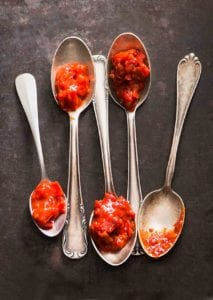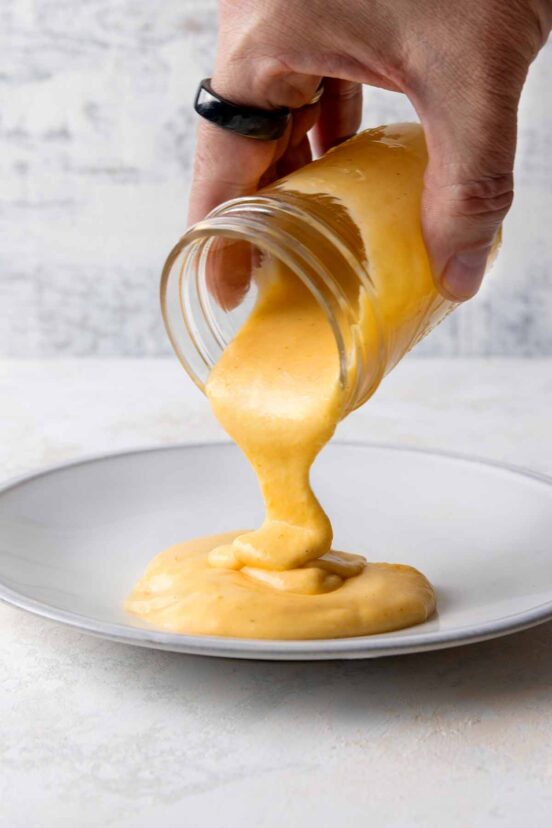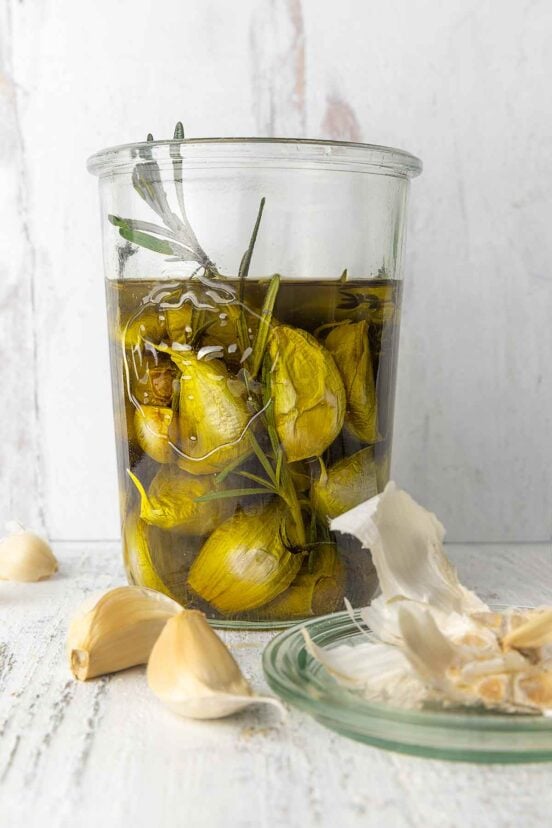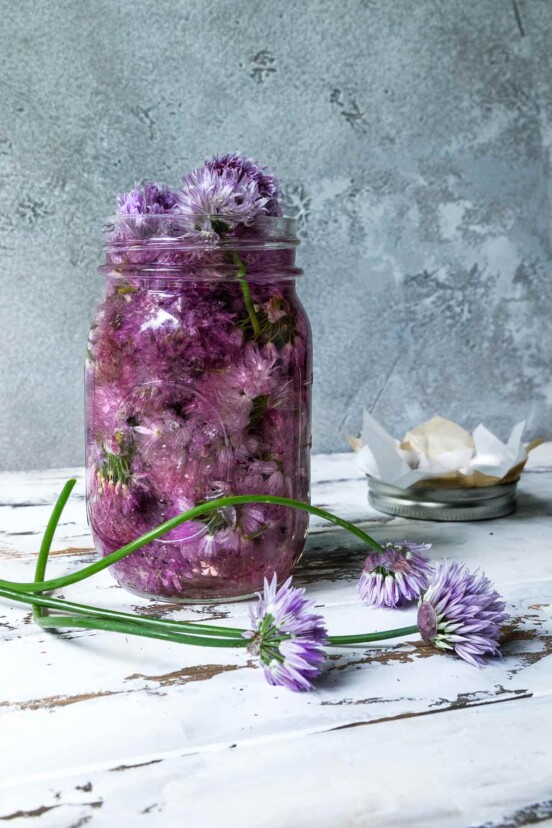
While you can find sambal oelek in jars, in Indonesia it’s always made fresh to order. You’ll love how much fresher tasting this quick option is. There are dozens of different types of chile paste in Indonesia that include the additions of garlic, shallots, lemongrass, and lime leaves. You can always add some bird or Thai chile peppers to make it spicier.
The Indonesian word oelek means “to grind,” and sambal oelek refers to a chile paste that’s ground in a mortar with a pestle. In its simplest form, this chile paste is made from chiles, salt, and lime juice.–Patricia Tanumihardja
How can I use sambal oelek?
This spicy Indonesian staple is incredibly versatile. You can…
Stir it into fried rice
Dribble it onto noodle dishes
Incorporate it into marinades, soups, and stews
Brush it onto grilled pork and other meats
Drizzle it onto eggs or tofu
Mix it with mayo and slather it on sandwiches (don’t forget burgers)

Sambal Oelek ~ Indonesian Chile Paste
Ingredients
- 2 1/2 ounces fresh long red chile peppers, such as Thai, serrano, or Fresno, seeded if desired, and chopped
- 1/8 teaspoon coarse sea salt or kosher salt, plus more to taste
- 1 tablespoon fresh lime or Key lime juice, plus more to taste
- Pinch sugar (optional)
Instructions
- In a mini food processor or a mortar, combine the chile peppers and salt.
☞ TESTER TIP: If you want to make this in bulk, simply multiply the ingredients as desired and use a food processor.
- Blitz the chiles in the food processor, scraping the sides as needed, or grind the chiles with the pestle using a twisting motion until pulpy.
☞ TESTER TIP: If your chiles have particularly thick skins, opt for a food processor, which will create a much smoother and more uniform consistency to your sauce.
- Stir in the lime juice, sugar, and/or salt. Taste and, if desired, stir in a little more lime juice. Serve immediately or transfer the chile paste to a jar and stash it in the fridge for up to 1 week.

Nutrition
Nutrition information is automatically calculated, so should only be used as an approximation.
Recipe Testers’ Reviews
Whoa. This is one seriously hot chile paste! After making and tasting to adjust the seasonings, I gave myself the nickname “Hot Lips” and wouldn’t even let my husband kiss me for fear of transferring some unintended spice! Ouff!
There’s so little effort that goes into making this that it now seems silly to ever again use store-bought sambal oelek. I used a food processor for ease of creating a double batch, and it took no time at all to get the right consistency. I seeded half of the chiles before processing, and wished I had seeded all of them. I did have to add more salt and sugar to balance the lime juice and to give the acidity more nuance. As an aside, many of the recipes I’ve seen for chile paste use vinegar, and I’m wondering if that might be a “rounder” way to flavor this, since the lime seemed a bit stark.
I love the bold red color of the paste and the ability to make it fresh in very small quantities. It’s very hot, but I can see us using it happily on all manner of rice dishes, lettuce wraps, omelettes, and grilled Asian-style flank steak or short ribs.
I don’t think I realized how quick and simple it could be to smash out a batch of sambal oelek, and now that I know, I can see me making this regularly to spice up dinner. I love the acidic hit of lime, and with just three or four ingredients and a few minutes of time, this is probably one of the easiest recipes to make!
It took just 7 minutes to gather together my ingredients, prep, and smash out this sambal oelek. So easy and delicious. I used red serrano chile peppers (6 in total) and left in the seeds. I love heat and rarely choose to risk a contact lens injury by removing seeds! I added an extra squirt of lime and a second pinch of fine salt to round out the flavor and balance the heat with some extra acid.
After finishing and scraping the smashed chile peppers from the mortar, I realized there were some larger pieces of chile skin (perhaps 1/3 inch or 1 cm square) which looked a little less appealing but didn’t affect the taste, I don’t think. Whether I had a taste of sambal with a larger piece of skin or not, the flavor and heat were the same, it perhaps just presents a little less well to have larger pieces. Next time I’ll try using a mini food processor (the kind that attaches to a stick blender) to see what texture I get.
The recipe says to use immediately but my leftovers are still going strong after 3 days.
I will for sure make this again. I store surplus fresh chile peppers in the freezer, so next time I’m going to try using those, which means I can whip up a fresh chile sauce any time, and will experiment using the frozen chile peppers I have on hand. I might also make it with vinegar instead of lime, as that would make it a really easy, fresh element to add to a dish that was from my pantry or freezer.
I used the sambal to make a citrus sambal sauce with lime and orange, which I tossed over some shrimp and made sambal shrimp lettuce wraps for dinner. Delicious!
This was amazing! I would have never guessed how easy it was to make fresh sambal oelek.
I used a combination of Fresno and Thai chile peppers. My initial sauce (using just the Fresno chiles) didn’t have much heat, it tasted more like a tangy mild hot sauce, even with the seeds. Once I added the Thai peppers, the flavor came alive. In my next batch, I added garlic because I was looking for the garlic chile sauce taste and it worked. I did add a pinch of sugar to the second batch because the garlic left a little bitter taste.
I put it on plain rice, just to get a good sense of the flavors without any other influences. After that I brushed it on grilled pork, which was fantastic. Chicken is next.
This is a super simple recipe and one to make if, like us, you have a glut of chile peppers in your summer garden! I like that it makes a small quantity because it avoids you having a large jar or bottle of hot sauce in your fridge forever!
Depending on the variety of chile you use, it might be easier to make this in a mini food processor because some skins are tougher than others and depending on the type or mortar and pestle you have, it might take a while to achieve the “pulpy” texture you are looking for. Be prepared to add a bit extra lime juice and/or sugar and/or salt to taste.
Result was just like the sambal oelek I have eaten in Indonesia so that’s a win!
















I’m thinking of subbing this for the sriracha here!
Sounds good, Elsa!
My garden peppers this year are very slow to ripen and I have several sauces that I make each year with the various varieties. Single variety sauces are just not going to happen. My last ripe collection consisted of Aji lemon drop, cayenne, paprika, and Lanterna picante. So that’s what I used to make this recipe! I left the seeds in and added yellow rock sugar and the lime juice and salt. Used my mini chopper. Perfect! It was still mostly red once ground up despite the yellow flecks from the Aji lemon peppers. There’s heat alright, but what an exquisite and simple sauce to make at home!
That sounds fantastic, Ilda! Thanks so much for taking the time to share this with us.